Overview
A strong upper level low pressure system moved across the western United States and eventually across southern New Mexico and west Texas during the weekend of February 10-11. Out ahead of this feature, moisture was able to move in across the region which allowed rain and snow showers to develop across the Panhandles by late morning on Saturday. Temperatures for most areas were above freezing, other than the northwest where temperatures were below freezing which allowed for snowfall to begin to accumulate across this area. On Saturday, between 1-3 inches of snow fell across the far northwest in areas like Texline, TX and Cimarron County in Oklahoma. A cold front pushed down late Saturday night into early Sunday morning and cooled temperatures down below freezing for the entire area. Early on Sunday, better lift provided by the low pressure system started to move across the Panhandles and allowed numerous bands of widespread snowfall to develop over the region. Snowfall rates up to a half inch to an inch per hour occurred in the heaviest snow bands. The system exited to the east during the evening on Sunday. Snowfall totals ranged anywhere from a Trace up to 7 inches across the Panhandles. The highest totals were located across the northwest, where 4-6 inches of snowfall was measured from Saturday into Sunday. The other area of higher totals was across the southern Texas Panhandle on Sunday, where snowfall accumulations ranged from 3.5 to 6.5 inches.
Snowfall
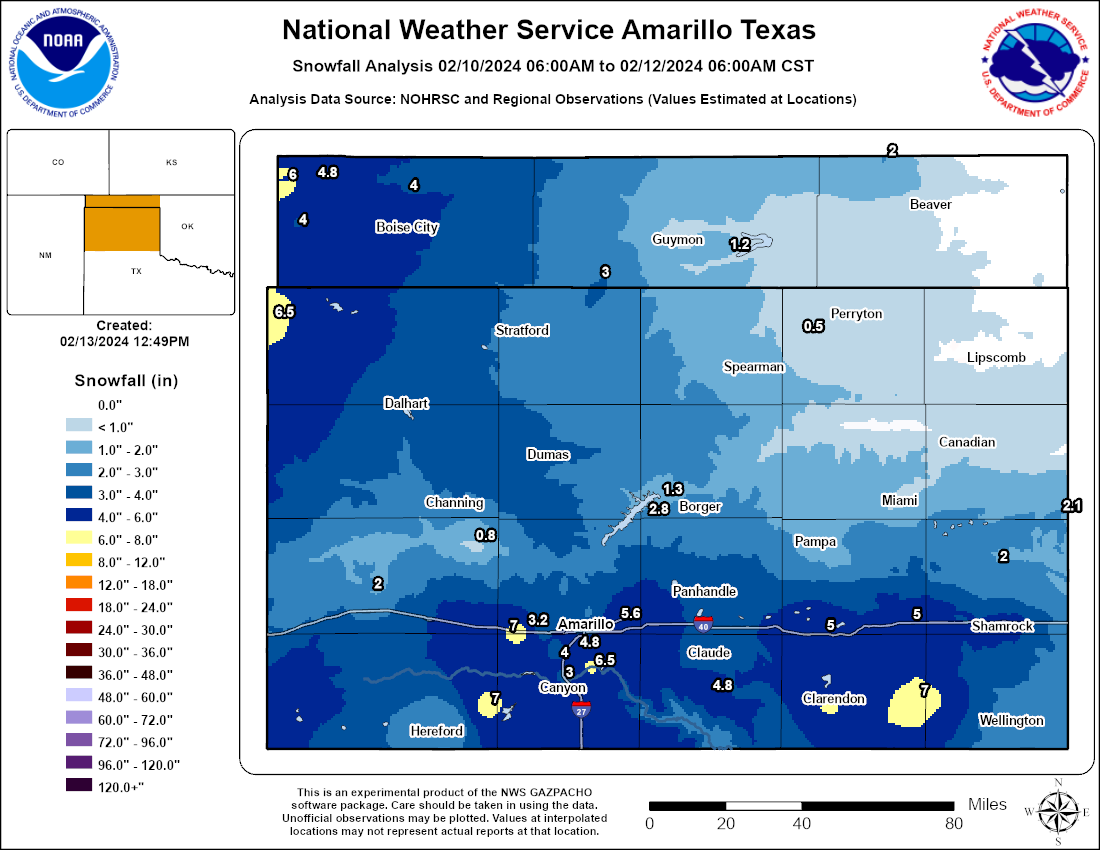
Photos & Video
Header
.jpg) |
.jpg) |
.jpg) |
.jpg) |
| Snowy driveway in Amarillo (Beto Castaneda) |
About 1.5 inches of snow measured in Borger (Charles Gillingham) |
Snowy backyard in Shamrock (Dana Kidd) |
Plenty of snow in Shamrock (Glenda Rodgers) |
.jpg) |
.jpg) |
.jpg) |
.jpg) |
| We don't exactly recommend riding a back on a snowy road in Amarillo (Jim Brisket) |
A snow covered Palo Duro Canyon (Matthew Regehr) |
Light drifting in Amarillo (Ronda Smelker) |
4 inches measured in Amarillo (Tricia Kennedy) |
Radar
Header
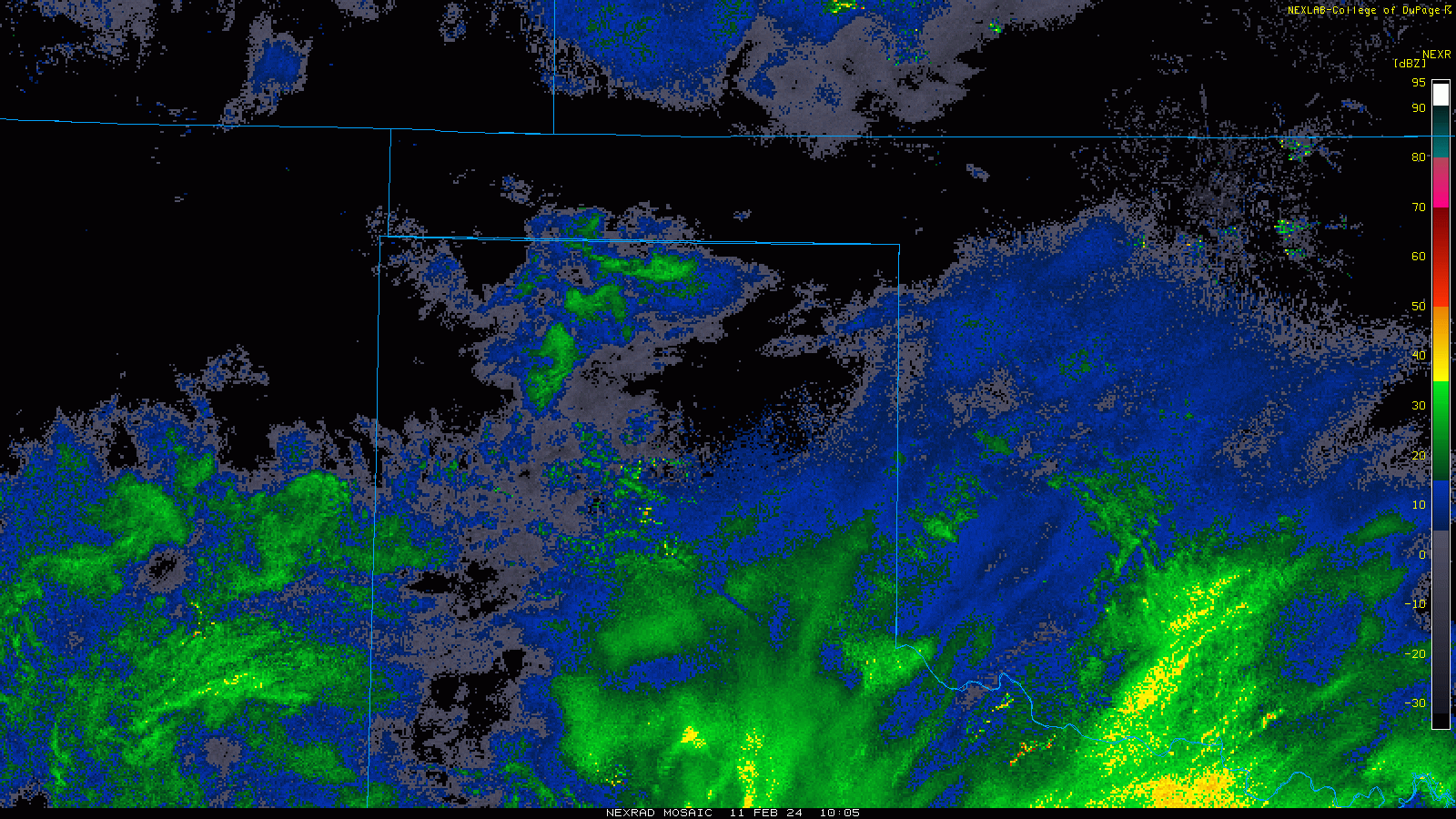 |
| Radar loop showing composite reflectivity through the event. The radar beam mostly overshot what occurred in the northwestern Panhandles, thus the lack of radar returns there. |
Storm Reports
Preliminary Local Storm Report...Summary National Weather Service Amarillo TX 948 PM CST Sun Feb 11 2024 ..TIME... ...EVENT... ...CITY LOCATION... ...LAT.LON... ..DATE... ....MAG.... ..COUNTY LOCATION..ST.. ...SOURCE.... ..REMARKS.. 0530 AM Snow Texline 36.38N 103.02W 02/11/2024 M6.0 inch Dallam TX Cocorahs 0600 AM Snow 7 ENE Amarillo 35.23N 101.71W 02/11/2024 M1.3 inch Potter TX Official NWS Obs 0640 AM Snow 4 W Wheeless 36.72N 102.97W 02/11/2024 M4.0 inch Cimarron OK Cocorahs 0650 AM Snow Borger 35.66N 101.40W 02/11/2024 M0.5 inch Hutchinson TX Emergency Mngr 0651 AM Snow 3 SE Dalhart 36.03N 102.48W 02/11/2024 M4.0 inch Hartley TX Public 0700 AM Snow 10.4 WSW Perryton 36.33N 100.98W 02/11/2024 M0.5 inch Ochiltree TX Cocorahs 0700 AM Snow 2 N Texhoma 36.53N 101.79W 02/11/2024 M3.0 inch Texas OK Public 0700 AM Snow Stratford 36.33N 102.07W 02/11/2024 M2.8 inch Sherman TX Public 0745 AM Snow 4 ENE Bushland 35.20N 102.00W 02/11/2024 M2.1 inch Potter TX Public 0800 AM Snow 1 NNE Black Mesa Park 36.87N 102.87W 02/11/2024 M4.5 inch Cimarron OK Cocorahs 1055 AM Snow 5 W Amarillo 35.19N 101.90W 02/11/2024 M3.0 inch Potter TX Trained Spotter 3 inches of snow measured at I-40 and Bell, with drifts of 8-10 inches. 1115 AM Snow 3 SSW Amarillo 35.16N 101.84W 02/11/2024 M3.5 inch Randall TX Public 1120 AM Snow 9 N Boise City 36.86N 102.51W 02/11/2024 E4.0 inch Cimarron OK Emergency Mngr HWY 287 will be closed from Boise City, OK to Campo, CO due to ice, snow cover, and several accidents. Many other roads/highways in Cimarron county are slick as well. Light snow still falling at time of report. 1200 PM Snow 2 S Greenbelt Lake 34.98N 100.92W 02/11/2024 E3.5 inch Donley TX Public Social Media report noted 3.5 inches of snow southwest of Greenbelt Lake. 1200 PM Snow 7 ENE Amarillo 35.23N 101.71W 02/11/2024 M3.6 inch Potter TX Official NWS Obs Still snowing. 1230 PM Snow 6 NNW Amarillo 35.29N 101.85W 02/11/2024 M2.5 inch Potter TX Broadcast Media 0200 PM Snow Guymon 36.68N 101.48W 02/11/2024 E1.0 inch Texas OK Law Enforcement Storm total. Snow has almost all melted. 0200 PM Snow 5 SW Amarillo 35.15N 101.87W 02/11/2024 M3.7 inch Randall TX Trained Spotter 0218 PM Snow 5 WSW Amarillo 35.17N 101.90W 02/11/2024 M4.0 inch Randall TX Public Picture from social media indicated 4 inches of snow had fallen. 0230 PM Snow 7 SW Amarillo 35.13N 101.91W 02/11/2024 M3.0 inch Randall TX Trained Spotter Still snowing. 0236 PM Snow Kenton 36.90N 102.97W 02/11/2024 M6.0 inch Cimarron OK Public Social media had two comments from two different people reporting 6 inches of snow in Kenton. 0246 PM Snow Timbercreek Canyon 35.06N 101.81W 02/11/2024 M6.5 inch Randall TX Public 6.5 inches measured near Timbercreek Canyon and Palisades. 0325 PM Snow Mclean 35.23N 100.60W 02/11/2024 M5.0 inch Gray TX Public Public report of 5.0 inches in McLean via social media. Snow still ongoing at time of report. 0339 PM Snow 3 N Timbercreek Canyon 35.09N 101.81W 02/11/2024 M6.0 inch Randall TX Public Still snowing. 0343 PM Snow 4 SSW Amarillo 35.15N 101.84W 02/11/2024 M5.4 inch Randall TX Trained Spotter Still snowing. 0345 PM Snow 4 SW Amarillo 35.16N 101.87W 02/11/2024 M4.8 inch Randall TX Public Social media post with a tape measure. 0400 PM Snow Clarendon 34.94N 100.89W 02/11/2024 E4.0 inch Donley TX Law Enforcement Still snowing. 0402 PM Snow 7 WSW Amarillo 35.15N 101.92W 02/11/2024 M4.0 inch Randall TX Trained Spotter 0459 PM Snow 2 WSW Amarillo 35.19N 101.86W 02/11/2024 M3.9 inch Potter TX Public Storm total. 0529 PM Snow 6 WSW Amarillo 35.17N 101.93W 02/11/2024 M4.0 inch Randall TX Trained Spotter Storm total. 0540 PM Snow 1 SSW Canadian 35.90N 100.39W 02/11/2024 E0.6 inch Hemphill TX Trained Spotter Storm total snow. Snow has melted. 0544 PM Snow Wheeler 35.45N 100.27W 02/11/2024 E2.0 inch Wheeler TX Law Enforcement Storm total snow. 0550 PM Snow 1 SSE Shamrock 35.21N 100.24W 02/11/2024 M4.6 inch Wheeler TX Trained Spotter Still snowing. 0557 PM Snow 1 SSE Wellington 34.85N 100.21W 02/11/2024 E2.5 inch Collingsworth TX Trained Spotter Still snowing lightly. 0602 PM Snow 1 WNW Claude 35.11N 101.37W 02/11/2024 E3.5 inch Armstrong TX Public 3 to 4 inches of snow. Storm total. Light snow off and on now. 0637 PM Snow 7 ENE Amarillo 35.23N 101.71W 02/11/2024 M5.6 inch Potter TX Official NWS Obs Storm total snow. 0639 PM Snow Canyon 34.98N 101.93W 02/11/2024 M6.0 inch Randall TX Trained Spotter Storm total snow. 0640 PM Snow Clarendon 34.93N 100.89W 02/11/2024 E6.0 inch Donley TX Public 0642 PM Snow 2 N Canyon 35.01N 101.92W 02/11/2024 M3.0 inch Randall TX Trained Spotter Storm total snow. 0654 PM Snow 8 ESE Bushland 35.13N 101.94W 02/11/2024 M3.5 inch Randall TX Trained Spotter Storm total snow. 0703 PM Snow/Ice Dmg Groom 35.20N 101.11W 02/11/2024 Carson TX Law Enforcement Several accidents reported along Interstate 40 in southern Gray County. 0703 PM Snow 1 S Pampa 35.54N 100.96W 02/11/2024 E1.5 inch Gray TX Law Enforcement 1 to maybe 2 inches. Storm total snow. 0736 PM Snow Hereford 34.82N 102.41W 02/11/2024 E1.5 inch Deaf Smith TX Law Enforcement 1 to 2 inches of snow. Storm total snow. 0758 PM Snow 10 S Claude 34.96N 101.36W 02/11/2024 M4.8 inch Armstrong TX Trained Spotter Storm total snow. 20 inch drifts. 0918 PM Snow Miami 35.69N 100.64W 02/11/2024 M0.5 inch Roberts TX Broadcast Media Storm total snow. && $$
Environment
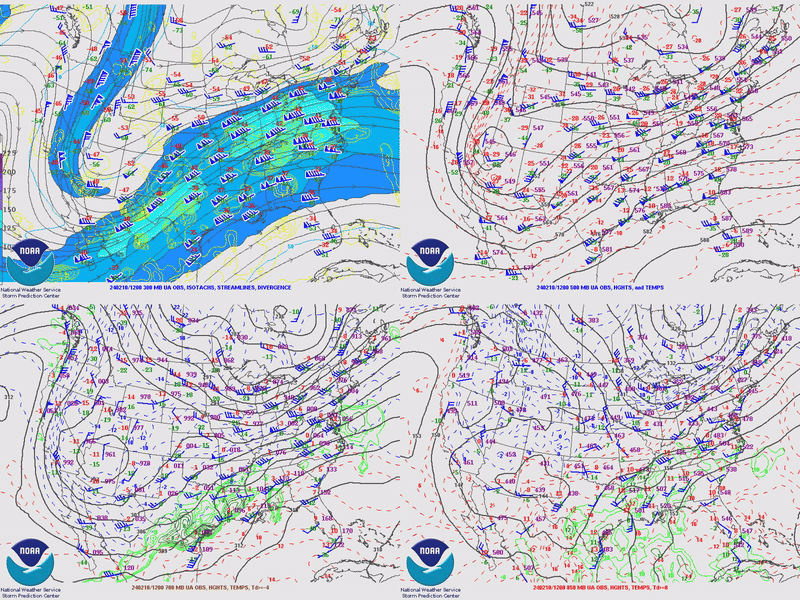 |
| Four panel look at 300/500/700/850mb analyses during the February 10th and 11th snow event. A deep large scale trough advanced eastward over the Panhandles, providing sufficient lift for snow to occur. |
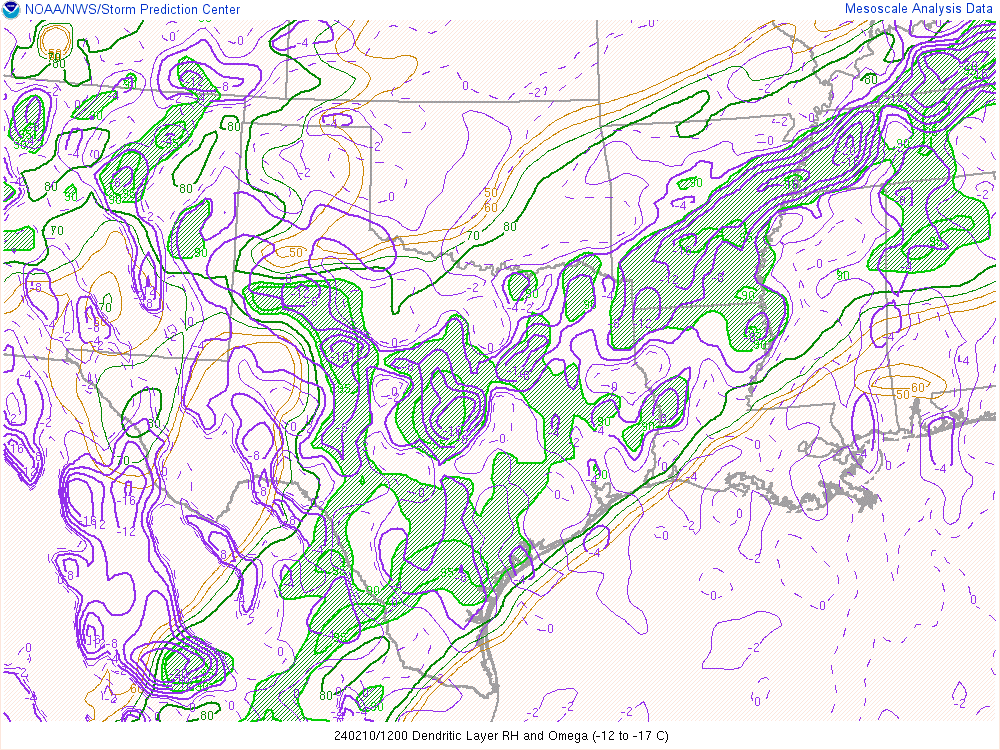 |
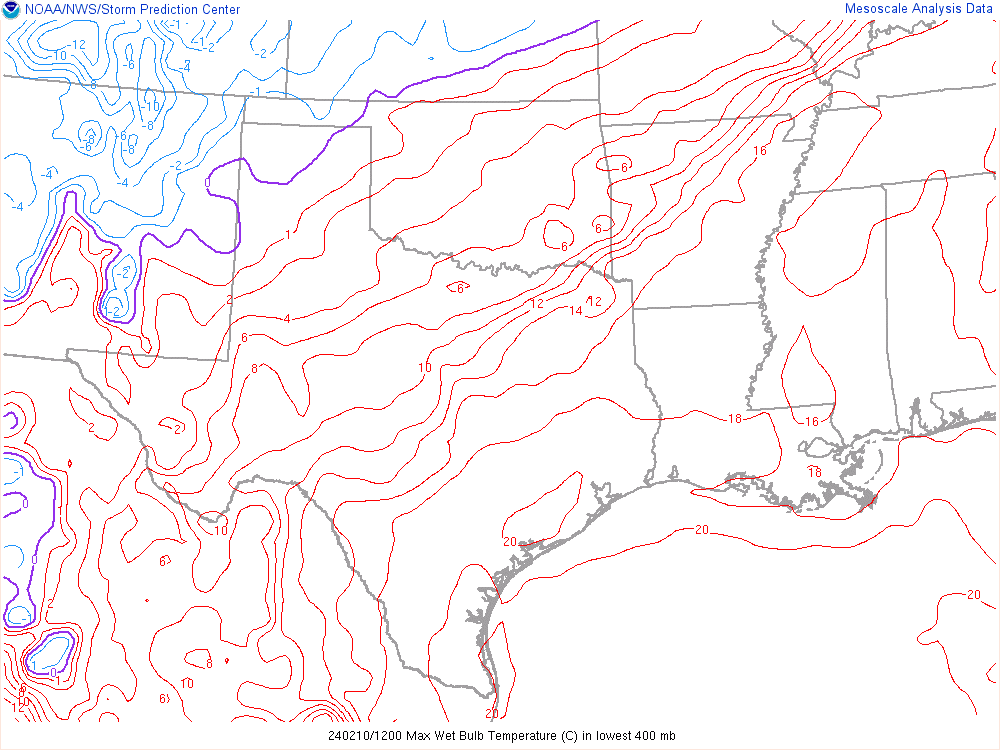 |
| Lift and moisture within the dendritic growth zone, the most favorable temperatures aloft for snow generation. When the dendritic growth zone is both saturated and experiencing strong lift, large snowflakes known as dendrites are generated and then fall to the ground. Both the northwestern Panhandles and southern Texas Panhandle had an extended period with favorable conditions for large snowflake development. | After those large flakes are generated higher up in the atmosphere, they have to fall to the ground without melting. This shows the warmest wet bulb temperature in the lower part of the atmosphere. When this is below zero, snowflakes will usually survive the fall without melting. This was below zero through the vast majority of the event. |
 |
Media use of NWS Web News Stories is encouraged! Please acknowledge the NWS as the source of any news information accessed from this site. |
 |